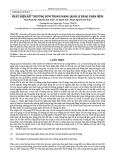
3
Chapter 3:
The Analyst as a
Project Manager
Systems Analysis and Design in a Changing
World, 3rd Edition
3
Systems Analysis and Design in a Changing World, 3rd Edition 2
Learning Objectives
Explain the elements of project management and
the responsibilities of a project manager
Explain project initiation and the activities in the
project planning phase of the SDLC
Describe how the scope of the new system is
determined
3
Systems Analysis and Design in a Changing World, 3rd Edition 3
Learning Objectives (continued)
Develop a project schedule using PERT and
Gantt charts
Develop a cost/benefit analysis and assess the
feasibility of a proposed project
Discuss how to staff and launch a project
3
Systems Analysis and Design in a Changing World, 3rd Edition 4
Overview
Fundamental principles of project management
Need both technical and management skills
How information system projects initiated
Part of overall strategic plan
Respond to immediate business need
Describe project planning phase of SDLC
Define scope of project
Compare estimated costs and benefits
Develop project schedule
3
Systems Analysis and Design in a Changing World, 3rd Edition 5
Project Management
People
Organizing
Directing
Planned result
Scheduling
Budgeting
Management: Getting things done through other
people
3
Systems Analysis and Design in a Changing World, 3rd Edition 6
Project Success Factors
Project management important for success of
system development project
2000 Standish Group Study
Only 28% of system development projects
successful
72% of projects cancelled, completed late, over
budget, and/or limited in functionality
Thus, project requires careful planning, control,
and execution

3
Systems Analysis and Design in a Changing World, 3rd Edition 7
Reasons for Project Failure
Incomplete or changing requirements
Limited user involvement
Lack of executive support
Lack of technical support
Poor project planning
Unclear objectives
Lack of required resources
3
Systems Analysis and Design in a Changing World, 3rd Edition 8
Reasons for Project Success
Clear system requirement definitions
Substantial user involvement
Support from upper management
Thorough and detailed project plans
Realistic work schedules and milestones
3
Systems Analysis and Design in a Changing World, 3rd Edition 9
Participants in a System
Development Project
3
Systems Analysis and Design in a Changing World, 3rd Edition 10
Overlap of SDLC Phases with Ongoing
Project Management Tasks
3
Systems Analysis and Design in a Changing World, 3rd Edition 11
Project Management Tasks Corresponding
to Phases of the SDLC
3
Systems Analysis and Design in a Changing World, 3rd Edition 12
Project Management Body of Knowledge
Scope management
Control functions included in system
Control scope of work done by team
Time management
Build detailed schedule of all project tasks
Monitor progress of project against milestones
Cost management
Calculate cost/benefit initial analysis
Monitor expenses

3
Systems Analysis and Design in a Changing World, 3rd Edition 13
Project Management Body of Knowledge
(continued)
Quality management
Establish quality plan and control activities for
each project phase
Human resource management
Recruit and hire project team members
Train, motivate, team build
Communications management
Identify stakeholders and their communications
Establish team communications
3
Systems Analysis and Design in a Changing World, 3rd Edition 14
Project Management Body of Knowledge
(continued)
Risk management
Identify and review risks for failure
Develop plans to reduce these risks
Procurement management
Develop requests for proposals (RFPs)
Evaluate bids, write contracts
Monitor vendor performance
3
Systems Analysis and Design in a Changing World, 3rd Edition 15
Project Initiation and the Project Planning Phase
Driving forces to start project
Respond to opportunity
Resolve problem
Conform to directive
Project Initiation comes from:
Long-term IS strategic plan (top-down) prioritized
by weighted scoring
Department managers or process managers
(bottom-up)
Response to outside forces (HIPAA)
3
Systems Analysis and Design in a Changing World, 3rd Edition 16
Initiating Customer Support System RMO
Strategic IS plan directs IS development’s project
priorities
Customer support system (CSS) selected
John MacMurty - creates project charter
Barbara Halifax - project manager
Steven Deerfield - senior systems analyst
Goal is to support multiple types of customer
services (Ordering, returns, on-line catalogs)
Project charter describes key participants
3
Systems Analysis and Design in a Changing World, 3rd Edition 17
RMO Project Charter
3
Systems Analysis and Design in a Changing World, 3rd Edition 18
Activities of the Project Planning Phase

3
Systems Analysis and Design in a Changing World, 3rd Edition 19
Activities of the Project Planning Phase
and Their Key Questions
3
Systems Analysis and Design in a Changing World, 3rd Edition 20
Defining the Problem
Review business needs
Use strategic plan documents
Consult key users
Develop list of expected business benefits
Identify expected system capabilities
Define scope in terms of requirements
Create system scope document
Build proof of concept prototype
Create context diagram
3
Systems Analysis and Design in a Changing World, 3rd Edition 21
Context Diagram for Customer Support
3
Systems Analysis and Design in a Changing World, 3rd Edition 22
Defining the Problem at RMO
Barbara: Completed problem definition statement
Steve: Conducted preliminary research on
alternative solutions
Barbara, Steve and William McDougal: Proceed
with analysis before making solution decisions
Barbara, Steve: Began schedule, budget,
feasibility statement for new system
3
Systems Analysis and Design in a Changing World, 3rd Edition 23
Producing the Project Schedule
Developing Work Breakdown Structure (WBS)
List of tasks and duration required for project
Similar to outline for research paper
WBS is foundation for project schedule
Building a PERT/CPM Chart
Assists in assigning tasks
Critical path method
Gantt chart and tracking GANTT chart
3
Systems Analysis and Design in a Changing World, 3rd Edition 24
Confirming Project Feasibility
Economic
Cost/benefit analysis
Sources of funds (cash flow, long-term capital)
Organizational and Cultural
Technological
Schedule
Resource
Feasibility Analysis –identify risks early to
implement corrective measures

3
Systems Analysis and Design in a Changing World, 3rd Edition 25
Economic Feasibility
Cost/benefit analysis (CBA)
Estimate project development costs
Estimate operational costs after project
Estimate financial benefits based on annual
savings and increased revenues
Calculate CBA using complete list of costs and
benefits
CBA uses net present value (NPV), payback
period, return on investment (ROI) techniques
3
Systems Analysis and Design in a Changing World, 3rd Edition 26
Supporting Detail for Salaries
and Wages for RMO
3
Systems Analysis and Design in a Changing World, 3rd Edition 27
Summary of Development Costs for RMO
3
Systems Analysis and Design in a Changing World, 3rd Edition 28
Summary of Annual Operating Costs
for RMO
3
Systems Analysis and Design in a Changing World, 3rd Edition 29
Sample Benefits for RMO
3
Systems Analysis and Design in a Changing World, 3rd Edition 30
RMO Cost Benefit Analysis

![Phát triển website quảng bá nhà hàng Sushi: Bài tập lớn [Chuẩn SEO]](https://cdn.tailieu.vn/images/document/thumbnail/2025/20251025/youtobeusa01@gmail.com/135x160/50491761551005.jpg)
























